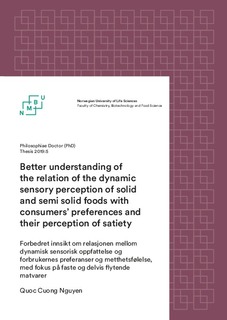| dc.description.abstract | Nowadays, overweight and obesity has been recognized as one of the main reasons
that leads to many non-communicable diseases such as diabetes, high blood pressure,
cardiovascular disease and in some cases cancer. Therefore, it is necessary to reduce or
at least control overweight and obesity. Some potential solutions have been proposed
but they have not been very successful due to the complexity and multi-dimensionality
of overweight and obesity. In this context, changing food intake or portion size selection
has been proposed as a potential effective solution. However, when changing the meal
size, one often changes or replaces food ingredients, which in turn, may change
consumer satisfaction. Therefore, the main challenge is to get a balance between
controlling meal size and satisfying consumer expectations. To deal with this challenge,
a holistic approach is required integrating both product (i.e. sensory attributes) and
consumer (i.e. expectations, characteristics) perspectives.
Previous research has found that the perception of texture is closely related to satiety
expectations and potentially, portion size selection. Sensory attributes are dynamic
perceptions that change from one moment to another moment during mastication, and
dynamic perception has been hypothesized to influence satiety perception. Thus,
temporal descriptive methods are recommended to capture these perceptions. Different
temporal methods may have both advantages and limitations. For that reason, the first
part of the thesis focuses on method comparisons with the purpose of pointing out the
most appropriate method to better understand dynamic perception and satiety related
expectations. Using food products with identical composition but varying in texture, the
results indicate that TCATA is more suitable for descriptive purposes, whereas TDS
could be better suited if the concern is the dominant attribute.
Solid and semisolid food products (barley bread, yoghurt) were characterized by
both static and dynamic sensory attributes. These attributes were used to identify the
drivers of consumer expectations (i.e. liking, satiation, satiety). From that, flavour was
found as the main attribute driving liking, whereas texture was deemed essential for
driving the expectations of satiation and satiety.
The next focus in the thesis was to investigate the relations between consumer
expectations and prospective portion size, in an integrated approach. In this framework,iv
exploratory blocks (i.e. liking, satiation, satiety) influence each other and together
predict the response block (i.e. portion size selection). A path modelling approach is a
valuable tool that estimates these relations and highlights blocks or variables which are
important in a prediction model. In this part of the thesis, both standard PLS-PM and
SO-PLS-PM, which deal with multi-dimensionality in blocks, were used. The results
demonstrated that liking was a key determinant of portion size selection. In addition,
satiety was predicted by satiation. These results were observed in two data sets
(yoghurt, biscuit) with different complexities of sensory properties. Added to this,
different groups of consumers showed different drivers for portion selection,
highlighting the importance of the study of individual differences in satiety perception.
In conclusion, this thesis provided three main findings: (1) temporal descriptive
methods are recommended to describe sensory perception particularly when relating
them to oral processing, and the methods are selected depending on the specific purpose
of each research; (2) consumer satiety expectations, and their relation to liking and
portion size selection are driven by different sensory modalities and subjected to
individual differences; and (3) the relations between consumer expectations can be
effectively modelled and interpreted using SO-PLS-PM. These results are important at
industrial level for developing satiety-related food products and from a methodological
point of view, in research applications. | nb_NO |

